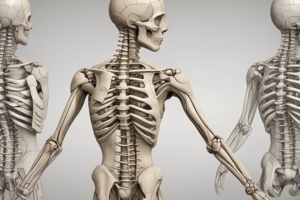Podcast
Questions and Answers
Which type of vertebral movement involves bending forward and decreasing the angle between vertebrae?
Which type of vertebral movement involves bending forward and decreasing the angle between vertebrae?
- Flexion (correct)
- Rotation
- Extension
- Lateral Flexion
In which spinal region is rotation more allowed compared to others?
In which spinal region is rotation more allowed compared to others?
- Thoracic Spine
- Sacral Spine
- Cervical Spine (correct)
- Lumbar Spine
What is primarily responsible for limiting flexion in the spine?
What is primarily responsible for limiting flexion in the spine?
- Intervertebral Discs
- Ligamentum Flavum
- Anterior Longitudinal Ligament
- Posterior Longitudinal Ligament (correct)
Which of the following best describes the function of the nucleus pulposus in intervertebral discs?
Which of the following best describes the function of the nucleus pulposus in intervertebral discs?
What characterizes the movement capabilities of the lumbar spine?
What characterizes the movement capabilities of the lumbar spine?
Which group of muscles is primarily responsible for extending and rotating the spine?
Which group of muscles is primarily responsible for extending and rotating the spine?
Which facet joint orientation contributes to more rotation in the cervical region?
Which facet joint orientation contributes to more rotation in the cervical region?
Which of the following statements about the thoracic spine is correct?
Which of the following statements about the thoracic spine is correct?
Flashcards are hidden until you start studying
Study Notes
Vertebral Movement
-
Definition
- Vertebral movement refers to the motion of vertebrae relative to one another in the spinal column.
-
Types of Vertebral Movement
- Flexion: Bending forward, decreasing the angle between vertebrae.
- Extension: Bending backward, increasing the angle between vertebrae.
- Lateral Flexion: Side bending, moving vertebrae toward the left or right.
- Rotation: Twisting motion around the vertical axis of the spine.
-
Functional Segments
- The spine is divided into regions, each with specific movement characteristics:
- Cervical Spine: Highly mobile, allows flexion, extension, lateral flexion, and rotation.
- Thoracic Spine: Limited flexion and extension due to rib attachments; allows some rotation.
- Lumbar Spine: Primarily allows flexion and extension; limited rotation.
- The spine is divided into regions, each with specific movement characteristics:
-
Facet Joints
- Facet joints guide and limit vertebral movements.
- Joint orientation varies by spinal region contributing to movement patterns:
- Cervical: Allows for more rotation.
- Thoracic: Facilitates rotation, limited flexion.
- Lumbar: Restricts rotation, allows flexion and extension.
-
Intervertebral Discs
- Act as shock absorbers and allow movement between vertebrae.
- Composed of:
- Nucleus Pulposus: Gel-like center providing cushioning.
- Annulus Fibrosus: Tough outer layer that contains the nucleus and supports movement.
-
Ligaments
- Support vertebral movement and stability:
- Anterior Longitudinal Ligament: Limits extension.
- Posterior Longitudinal Ligament: Limits flexion.
- Ligamentum Flavum: Connects adjacent laminae; aids in flexion and extension.
- Support vertebral movement and stability:
-
Muscles Involved
- Deep and superficial muscles stabilize and enable movement:
- Erector Spinae: Extends and rotates the spine.
- Transversospinalis: Provides stability and aids in rotation.
- Abdominal Muscles: Facilitate flexion and provide stability.
- Deep and superficial muscles stabilize and enable movement:
-
Biomechanical Considerations
- Movement patterns affect stress distribution on discs and vertebrae.
- Importance of posture and movement mechanics to prevent injury.
- Cumulative loading can lead to degeneration of discs and joints.
Vertebral Movement
- Vertebral movement is the motion of vertebrae relative to one another in the spinal column.
- Types of Vertebral Movement:
- Flexion: Involves bending forward and decreasing the angle between vertebrae.
- Extension: Bending backward, which increases the angle between vertebrae.
- Lateral Flexion: Side bending motion that moves vertebrae toward the left or right.
- Rotation: Twisting motion occurring around the vertical axis of the spine.
Functional Segments of the Spine
- The spine is categorized into distinct regions, each with unique movement capabilities:
- Cervical Spine: Highly mobile region that permits flexion, extension, lateral flexion, and rotation.
- Thoracic Spine: Offers limited flexion and extension due to rib attachments but allows some rotation.
- Lumbar Spine: Primarily allows flexion and extension with restricted rotational movement.
Facet Joints
- Facet joints play a critical role in guiding and limiting vertebral movements.
- Their orientation varies among spinal regions, influencing movement patterns:
- Cervical spine allows the most rotation.
- Thoracic spine facilitates rotation but has limited flexion capability.
- Lumbar spine restricts rotation while allowing flexion and extension.
Intervertebral Discs
- Intervertebral discs act as shock absorbers and enable movement between vertebrae.
- Structure includes:
- Nucleus Pulposus: A gel-like center that provides cushioning.
- Annulus Fibrosus: A tough outer layer that encases the nucleus and supports vertebral movement.
Ligaments
- Ligaments provide support and stability for vertebral movement:
- Anterior Longitudinal Ligament: Restricts extension of the spine.
- Posterior Longitudinal Ligament: Limits the forward bending or flexion.
- Ligamentum Flavum: Connects adjacent laminae and assists in flexion and extension.
Muscles Involved
- Both deep and superficial muscles are essential for stabilizing and enabling spinal movement:
- Erector Spinae: Responsible for extending and rotating the spine.
- Transversospinalis: Aids in providing stability and assists in rotational movements.
- Abdominal Muscles: Facilitate spinal flexion and stability.
Biomechanical Considerations
- Movement patterns influence the distribution of stress on intervertebral discs and vertebrae.
- Proper posture and movement mechanics are crucial for preventing injuries.
- Cumulative loading on discs and joints can lead to degeneration over time.
Studying That Suits You
Use AI to generate personalized quizzes and flashcards to suit your learning preferences.




